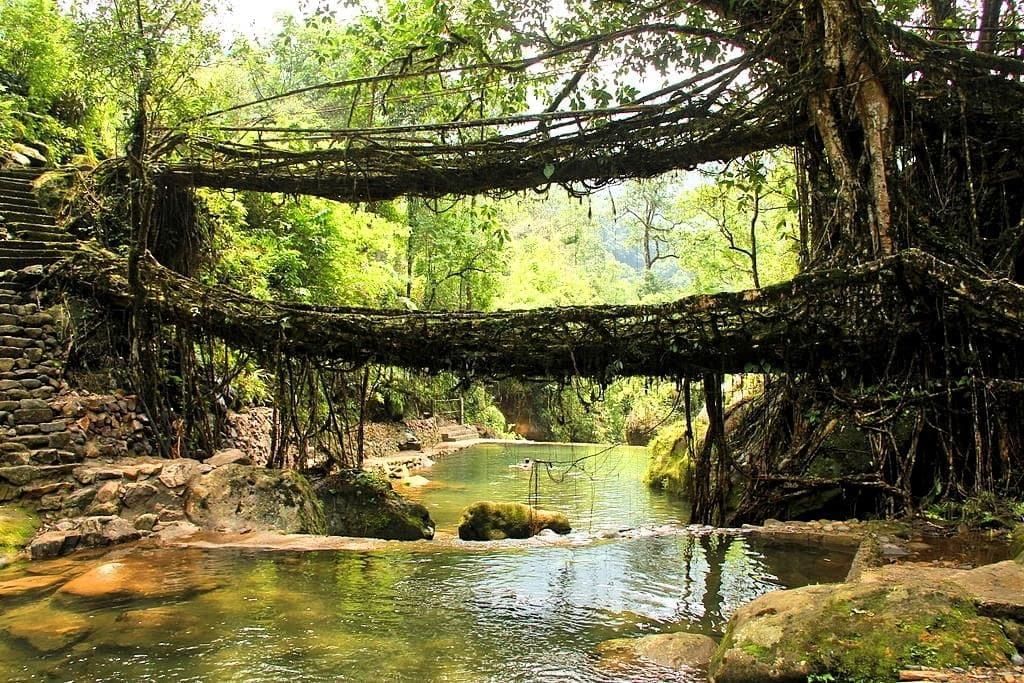Short and Long Answer Questions: Spectacular Wonders | English Poorvi Class 8 - New NCERT PDF Download
Short Answer Questions
Q1. Describe the Valley of Flowers and what makes it special.
Ans: The Valley of Flowers in Uttarakhand is filled with nearly 600 kinds of exotic plants like orchids, poppies, and daisies. It looks like a colourful carpet against the backdrop of the Himalayas. Trekkers enjoy waterfalls, streams, and even rare wildlife such as the snow leopard and red fox. It is a UNESCO World Heritage Site and becomes a true wonderland between May and October.
Q2. Why are the living root bridges of Meghalaya considered unique?
Ans: The living root bridges are made without cement or steel; instead, they are formed by intertwining the roots of trees. These bridges are strong enough to last hundreds of years and withstand monsoon rains. They show the knowledge and creativity of the local people. Some bridges are over 100 feet high and 175 feet long, making them natural wonders as well as cultural heritage.
 Living Root Bridge, Meghalya
Living Root Bridge, Meghalya
Q3. How did the Lonar Crater Lake come into existence?
Ans: The Lonar Crater Lake in Maharashtra was created thousands of years ago when a meteorite struck Earth at high speed. The collision left behind a perfectly round crater in basaltic rock, which is extremely rare. Today, a saline lake sits inside this crater, creating a striking sight against rugged surroundings. It is one of the world’s largest craters and a blend of science and natural beauty.
Q4. What happens at Magnetic Hill, and why do people find it mysterious?
Ans: At Magnetic Hill in Ladakh, vehicles left in a marked spot seem to move uphill without any effort. Tourists are amazed, as it looks like gravity has disappeared. In reality, the effect is an optical illusion created by the shape of the surrounding land. Still, it remains a fascinating attraction for visitors.
Q5. What causes the glowing waters of Kerala, and why are they important?
Ans: In Kumbalangi village near Kochi, the waters glow at night due to bioluminescence. This happens because of tiny organisms called micro-planktons that emit light. The glowing water attracts many tourists and supports eco-tourism in the area. It also lets visitors experience village life and learn about its culture and food.
Q6. Why are the Sundarbans important both ecologically and culturally?
Ans: The Sundarbans is the world’s largest mangrove forest, spread across West Bengal. Its roots hold the coastline together, protecting it from erosion and storms. The area is rich in biodiversity with species like the Bengal tiger, crocodiles, and many birds. Named after the sundari tree, the Sundarbans are both a natural shield and a cultural treasure.
Q7. What makes Chandipur Beach in Odisha so unusual?
Ans: Chandipur Beach is known for its sea that “disappears” every day. During ebb tide, the water retreats 2–5 km, and during high tide, it returns. This unique natural event lets people walk on the sea bed and then watch the waves return. It feels like a magical game of hide-and-seek played by the sea.
Long Answer Questions
Q1. Compare the Valley of Flowers and the Living Root Bridges as examples of natural wonders.
Ans: The Valley of Flowers in Uttarakhand is a breathtaking garden of rare plants and animals set against the Himalayas. It is a UNESCO site and changes into a paradise during summer and monsoon. The Living Root Bridges of Meghalaya, on the other hand, show the creativity of humans working with nature. Instead of being planted by chance, they are grown and guided by local people, becoming bridges that last for centuries. Both wonders represent the harmony of nature’s beauty and human respect for the environment, making them treasures of India.
Q2. What makes the Lonar Crater Lake and Magnetic Hill fascinating examples of natural mysteries?
Ans: The Lonar Crater Lake in Maharashtra was created by a meteorite impact, making it one of the world’s largest basaltic craters. It holds a saline lake at its core and stands as evidence of Earth’s ancient history. Magnetic Hill in Ladakh, by contrast, is not about history but illusion. It makes vehicles appear to roll uphill, confusing the eyes of visitors. Both are extraordinary examples of how science and mystery come together in India’s landscapes. One shows nature’s destructive force, while the other reveals the tricks of perception.
Q3. How do the Glowing Waters of Kerala, the Sundarbans, and Chandipur Beach show the diversity of India’s natural wonders?
Ans: The glowing waters of Kerala shine because of living micro-organisms, turning nights magical. The Sundarbans, meanwhile, is a massive mangrove forest that protects coasts and shelters species like the Bengal tiger. Chandipur Beach in Odisha is different again, as it makes the sea vanish and reappear daily. Together, these three show the variety of India’s landscapes—from seas to forests to villages. They highlight nature’s creativity, its power to protect, and its ability to surprise. Such wonders remind us that India’s environment is not only diverse but also deeply magical.
|
60 videos|520 docs|57 tests
|
FAQs on Short and Long Answer Questions: Spectacular Wonders - English Poorvi Class 8 - New NCERT
| 1. What are some of the most famous natural wonders of the world? |  |
| 2. How do natural wonders contribute to biodiversity? |  |
| 3. What factors threaten natural wonders today? |  |
| 4. What role do natural wonders play in cultural heritage? |  |
| 5. How can individuals help preserve natural wonders? |  |















